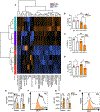Metformin treatment rescues CD8+ T-cell response to immune checkpoint inhibitor therapy in mice with NAFLD
- PMID: 35378172
- PMCID: PMC9391315
- DOI: 10.1016/j.jhep.2022.03.010
Metformin treatment rescues CD8+ T-cell response to immune checkpoint inhibitor therapy in mice with NAFLD
Abstract
Background & aims: Non-alcoholic steatohepatitis (NASH) represents the fastest growing underlying cause of hepatocellular carcinoma (HCC) and has been shown to impact immune effector cell function. The standard of care for the treatment of advanced HCC is immune checkpoint inhibitor (ICI) therapy, yet NASH may negatively affect the efficacy of ICI therapy in HCC. The immunologic mechanisms underlying the impact of NASH on ICI therapy remain unclear.
Methods: Herein, using multiple murine NASH models, we analysed the influence of NASH on the CD8+ T-cell-dependent anti-PD-1 responses against liver cancer. We characterised CD8+ T cells' transcriptomic, functional, and motility changes in mice receiving a normal diet (ND) or a NASH diet.
Results: NASH blunted the effect of anti-PD-1 therapy against liver cancers in multiple murine models. NASH caused a proinflammatory phenotypic change of hepatic CD8+ T cells. Transcriptomic analysis revealed changes related to NASH-dependent impairment of hepatic CD8+ T-cell metabolism. In vivo imaging analysis showed reduced motility of intratumoural CD8+ T cells. Metformin treatment rescued the efficacy of anti-PD-1 therapy against liver tumours in NASH.
Conclusions: We discovered that CD8+ T-cell metabolism is critically altered in the context of NASH-related liver cancer, impacting the effectiveness of ICI therapy - a finding which has therapeutic implications in patients with NASH-related liver cancer.
Lay summary: Non-alcoholic steatohepatitis represents the fastest growing cause of hepatocellular carcinoma. It is also associated with reduced efficacy of immunotherapy, which is the standard of care for advanced hepatocellular carcinoma. Herein, we show that non-alcoholic steatohepatitis is associated with impaired motility, metabolic function, and response to anti-PD-1 treatment in hepatic CD8+ T cells, which can be rescued by metformin treatment.
Keywords: Hepatic intravital imaging; Hepatic transcriptomics; Immunometabolism; Liver cancer; Metabolic syndrome; NASH immunology.
Published by Elsevier B.V.
Conflict of interest statement
Conflicts of interest The authors declare no conflicts of interest. Please refer to the accompanying ICMJE disclosure forms for further details.
Figures





Comment in
-
Metformin keeps CD8+ T cells active and moving in NASH-HCC immunotherapy.J Hepatol. 2022 Sep;77(3):593-595. doi: 10.1016/j.jhep.2022.05.038. Epub 2022 Jun 15. J Hepatol. 2022. PMID: 35714813 No abstract available.
-
Metformin in patients with hepatocellular carcinoma receiving immunotherapy.J Hepatol. 2023 May;78(5):e180-e182. doi: 10.1016/j.jhep.2022.12.011. Epub 2022 Dec 23. J Hepatol. 2023. PMID: 36572351 No abstract available.
References
Publication types
MeSH terms
Substances
Grants and funding
LinkOut - more resources
Full Text Sources
Medical
Molecular Biology Databases
Research Materials

